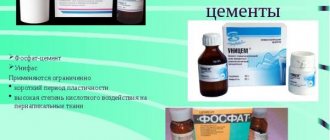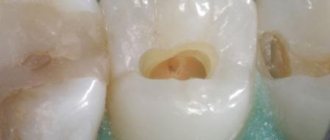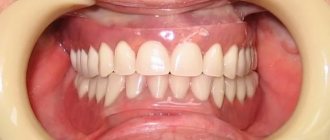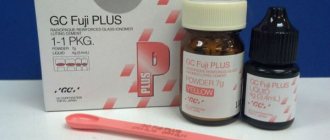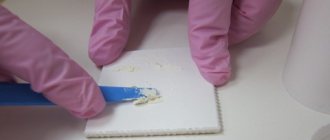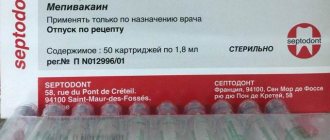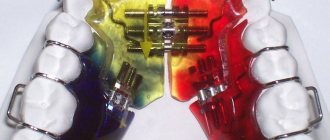- general information
- Compound
- Advantages of the drug
- Flaws
- Mode of application
- Review of manufacturers
- Price
Almost all patients, having decided on artificial restoration of teeth through prosthetics, know little about the materials used during the operation. Perhaps very few people know that there are a huge number of cement composites, each of which is designed for a particular clinical case. What is glass ionomer cement, what are its features and advantages, manufacturing specifics and varieties - this material is dedicated to this.
General information about glass ionomer cement
Glass ionomer cements (hereinafter referred to as GIC) are the latest innovative mixtures characterized by a heterogeneous structural content, where the base part is aluminosilicate glass, and polyacrylic acids act as a polymer matrix.
GIC is the optimal solution for placing fillings on a temporary basis, as well as being used as insulating liners.
Initially liquid in consistency, the mass gradually hardens and takes on the desired state. This happens in several stages:
- dissolution – the process of formation of ions;
- gelation – creation of gel-polymer chains, increase in pH level. The duration of the transition to this state is about 5 minutes;
- complete hardening of the material occurs within 24 hours.
The mixture reacts well with hard tooth tissues, intensely releasing fluoride elements. It is characterized by an average degree of strength, interacts better with enamel than with dentin tissue, and has an inhibitory effect on previously formed caries manifestations.
Composition of glass ionomer cement
The filling component consists of standard elements for such materials - distilled water and powder mass. As a result of their interaction, they become solid from a liquid state - this is ensured by the influence of acidic processes.
Most often, alkene polymers are used to create GIC:
- maleic;
- polyacrylic;
- itaconic.
They help reduce the viscosity of cement, slow down the process of gelation of the liquid and bind all the elements into a homogeneous mass several times faster. These qualities have a positive effect on the service life of the composition.
The liquid part basically contains distillers or tartaric acid. Powder – calcium silicate glass and calcium fluoride drops.
Upon completion of the filling processes, fluoride ions begin to be actively released into the oral cavity, which is an excellent obstacle to the development of secondary caries manifestations. The silicate substance is necessary for proper acid reactions to occur. Mineral substances in contact with glass form a silicon film, which is subsequently impregnated with acidic masses. In this case, the processing time becomes shorter, and the hardening time, on the contrary, becomes longer. The same principle is used to ensure hygroscopic reduction.
Advantages of glass ionomer cement
Glass ionomers have the following advantages, in comparison with analogue filling materials:
- ease of use - cement fills the cavity in one or two portions. Its use does not involve the processes of preliminary etching of the area and bonding of dentin;
- the unique property of hardening even in a humid environment - this quality ensures the active use of the composition in the treatment of caries cavities in the cervical zone, elimination of wedge-shaped pathologies, as well as caries, the affected area is the area located below the gum level;
- connection of the component with the tissues of dentin and enamel according to the intermolecular principle - makes it possible to install fillings with excellent marginal fit and eliminates the need to create retention areas during the treatment of the organ;
- complete adhesion to compositions with clove oil - thus, GIC is used as insulating liners that protect fabrics from excessive attachment of composites to them;
- adhesion to metal components;
- the ability to release ion enzymes into the organ cavity for at least a year after the filling is installed;
- weak shrinkage during polymerization - at the moment of transformation into a solid state, cement slightly increases in volume, which partially compensates for shrinkage processes;
- no irritating effect on dentin and pulp tissue - their composition is not aggressive and not dangerous in the treatment of deep caries if cement is used as a spacer;
- the thermal expansion indicator corresponds to the coefficient of expansion of the organ tissue - in such a situation, the filling is fixed more reliably, lasts longer, and its marginal fit is an order of magnitude better. This is a good preventive protection against the formation of damage to the enamel surface - cracks, chips.
Zinc oxide eugenol based sealers in endodontic practice
My long professional career has allowed me to work with different sealers. During the period of Soviet dentistry, these were resorcinol-formalin paste, paracin, zinc phosphate, zinc oxide eugenol cements. Filling was carried out with one paste or cement. In the 90s of the twentieth century, various sealers appeared on the market, new technologies that became available to us. In my speeches, I now talk about systems for passing root canals, systems for their obturation, and the need to comply with endodontic principles. In this case, the choice of sealer is entirely up to the doctor and depends on many both subjective and objective factors.
A wide range of sealers are used in endodontic practice. Their physicochemical properties are developed taking into account the requirements for this group of materials. The basic requirements were defined back in 1940 by L. Grossman 9 and formed the basis of the supposed ideal material.
The sealer must:
- easy to enter and remove if necessary;
- do not decrease in volume during curing;
- do not dissolve in the root canal;
- be impermeable to tissue fluid;
- do not have a toxic or irritating effect on periodontal tissue or the body as a whole;
- stimulate regeneration processes;
- have bactericidal and bacteriostatic properties;
- do not stain the tooth;
- be radiopaque.
These requirements subsequently formed the basis for the ISO standard in endodontics. 7 The introduction of composite filling materials added another requirement - compatibility of the sealer with them.
Historically, zinc oxide eugenol pastes, modified for endodontic use and designated as root canal cements, were widely used as root fillings. They are characterized by ease of production and, therefore, cost-effectiveness. The liquid for these materials is eugenol, which has a pronounced antibacterial effect. The powder of materials in this group consists of finely sifted zinc oxide to increase the fluidity of cement. Zinc oxide has an antimicrobial effect by inhibiting the growth and activity of microorganisms and is involved in many metabolic processes. It has been established that it provides cytoprotection of tissue cells. 4
Disadvantages of glass ionomer cement
The material is not without its shortcomings, some of which are quite significant:
- long maturation of the cement composition - it completely hardens only a day after installation, despite the fact that the first setting occurs within a few minutes;
- in the first hours the mixture is sensitive to a humid environment - it is at that stage that active leaching of ions occurs, which slows down the processes of final polymerization;
- poor resistance of the structural content to mechanical vibration - the material cannot be affected by a conventional drill immediately after installing the filling;
- etching of organ tissue is unacceptable;
- limited use for complex caries with a deep damaging effect;
- poor resistance to diametric tension, which completely excludes the use of GIC for the treatment of occlusal surfaces, as well as in clinical situations when the load on the tooth is distributed in different directions;
- shorter service life compared to conventional cement composite;
- average level of aesthetics, which limits its use on the frontal areas of the jaw row.
Indications and contraindications
Indications for the use of a specific brand of material depend on its purpose (fixing, restoration or cushioning).
Fixing compounds (in particular, Fuji 1) are used for the following operations:
- fixation of MVP and microprostheses made of metal ceramics and metal;
- fastening of MVP, crowns, onlays and inlays made of composite;
- fixation of any types of metal-free prostheses, including zirconium oxide;
- fastening of intra-channel pins from various materials.
Contraindications for the use of different brands of Fuji cement are almost the same for all materials and include:
- the presence of direct contact of the material with the pulp (there should be no contact);
- Hypersensitivity in a particular patient to cement components is rare.
Direct contact of the material with the pulp is prevented by applying a calcium hydroxide gasket. If you are allergic to a specific material, you need to replace it with another one that does not contain the allergen.
Method of using glass ionomer cement
The algorithm for using standard glass ionomer cements is as follows:
- thorough treatment of the working area with a conditioning liquid, which is washed off 20 seconds after application and the cavity is well dried;
- the damaged tooth is isolated from moisture and salivary secretions for the entire period of setting of the mass - about 5 - 6 minutes;
- the liquid and powder composition are mixed until a shiny, homogeneous thick mass is obtained;
- they place it in the organ cavity and form a filling, while ensuring dense condensation using a cotton swab or a special device with a spherical movable working tip;
- after giving the filling the desired shape, its relief is coated with varnish;
- after 1 – 2 days, treat with a drill. After this, the tooth can function normally.
Reviews
JC cements are widely used by dentists in different countries, including Russian ones. So, citizens who have had their teeth treated at least once are likely to have fillings made from Fuji brand materials.
If you were one of them, tell us how successful the treatment was, how long did the crown fixed with cement or the tooth restored with its help last? You can leave your comment at the bottom of this page.
If you find an error, please select a piece of text and press Ctrl+Enter.
Tags crown material
Did you like the article? stay tuned
No comments yet
Overview of glass ionomer cement manufacturers
Despite the fact that the composition of the GICs of the main manufacturers is almost identical, the following line of leading manufacturers are distinguished in the domestic market of dental materials, firmly holding the rating for a long period of time. It is advisable to consider the features in more detail.
Arde Kwik Tsem
It is a fluid hybrid mixture of a double solidification principle. Ideal for attaching veneers, bridge devices, and inserting pins during restoration with implants.
Thanks to its unique structural content and viscous consistency, it ensures the highest quality filling of the tooth cavity.
It has a serious disadvantage - it can provoke individual intolerance and cause allergic reactions of varying degrees of intensity.
Arde Fix
It is used for permanent fixation of orthodontic and prosthetic devices. Not prone to dissolution and oxidation in the oral cavity. If the composition is mixed correctly, side effects and complications are completely excluded. May cause a short-term decrease in the sensitivity of taste buds, which resolves spontaneously after some time. It does not tolerate the presence of eugenol elements in the work area.
Fuji Plus
A distinctive feature of the mixture is its modification with a composite, which provides a number of advantages:
- stronger fixation;
- possibility of use when interacting with metal, non-metal, ceramic prosthetic structures of all types in the process of orthopedic manipulations.
The disadvantage is the weaker light reflectivity of the material in the solid state.
Ketak Tsem
The main advantage is simplicity and ease of use. Shorter time for manual mixing and bringing to the required consistency.
It has high aesthetic indicators - a matte, slightly silky surface, which is especially important when working on the frontal area of the jaw.
The disadvantage is sensitivity to low temperatures, which increase the hardening time.
Tsemion F
The composition has good radiopacity, withstands high mechanical loads in comparison with analogue products, and has a low solubility index.
Adhesive to enamel and dentin tissues.
Allows you to achieve a high level of marginal sealing, releases fluoride over a longer period of time, which helps strengthen tooth enamel. It has a low pain sensitivity threshold and causes virtually no discomfort in patients during the rehabilitation period after treatment.
Partial pulpotomy according to Cvek
Cvek pulpotomy is named after Dr. Miomir Cvek, who promoted the partial pulpotomy technique. This method involves removing necrotic pulp or part of the exposed pulp, leaving only healthy pulp in the apical zone in order to maximize the preservation of viable tissue in the dental pulp. Next, healing material is placed to cover the remaining pulp. 21
For many years, calcium hydroxide was used for pulp capping, but soon calcium silicate, such as the mineral trioxide aggregate, began to show mixed results in treatment. 22 The preservation of viable pulp has been demonstrated in histological studies in which pulpal response remained as caries progressed. As caries progressed, the pulp began to react to bacterial invasion; The study showed that even in the presence of inflammation, necrosis in the coronal part of the pulp, there may still be healthy pulp underneath. 23
Clinical case 4: Accidental opening and subsequent restoration of a tooth
An 11-year-old boy complained of pain in the lower jaw on the left. Previously, he had consulted a dentist, who prescribed him a course of antibiotics and referred him to an endodontist for root canal treatment, but the patient was never able to visit a specialist. The patient reported mild, intermittent tooth pain.
When examining tooth 3.6, a deep carious cavity was revealed on the chewing surface. The cold test was positive, the pain disappeared immediately after the removal of the irritant. The x-ray revealed a deep carious cavity with damage to hard tissues of more than 2/3, the stage of an unformed root. Diagnosis: reversible pulpitis without pathological periapical changes.
Glass ionomer cement price
Depending on the manufacturer, the cost of cement of various brands looks something like this:
Arde Kwik Cem - from 1,300 rub.
Arde Fix - from 1,420 rub.
Fuji Plus - from 1,520 rub.
Ketak Tsem - from 1,380 rub.
Tsemion F - from 1,240 rub.
Having placed a filling from the material discussed in this article, you don’t have to worry that after a short time it will crumble under temperature or mechanical influence. And although in some respects cement is inferior to more expensive mixtures, with proper use the tooth will retain its functionality for a fairly long period of time.
What materials are used for temporary filling?
Temporary fillings are installed in cases where treatment requires several visits to the doctor. For example, to eliminate the inflammatory process or kill the nerve during pulpitis, the doctor places the appropriate medicinal substance and covers it with a special filling material on top. This ensures a hermetically sealed cavity, which prevents bacteria and infection from entering. But unlike permanent fillings, the material for temporary fillings may not be as durable. Read further in this article about what formulations are used for this.
